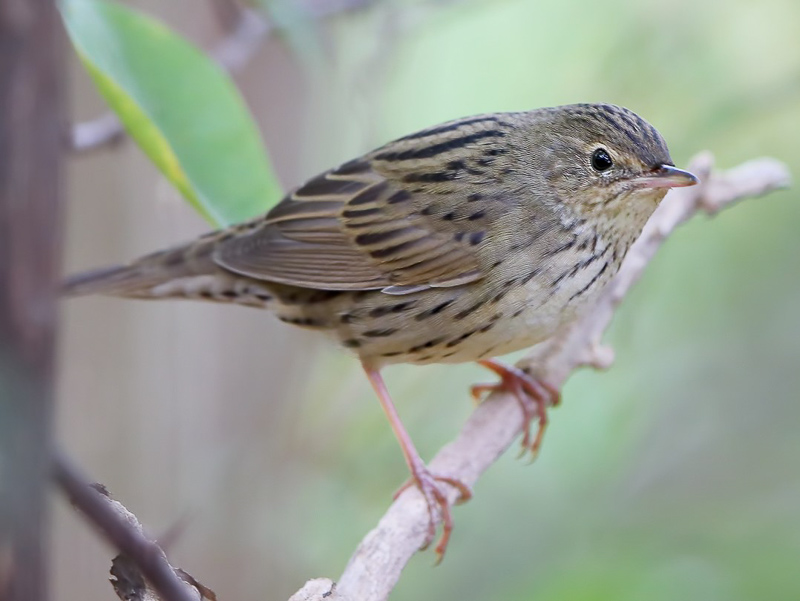Lanceolated Warbler Locustella lanceolata 矛斑蝗鶯
Category I. Common passage migrant in autumn but rare in winter and spring; favours wetland areas but can occur in diverse densely vegetated habitats.
IDENTIFICATION

Nov. 2020, Michelle and Peter Wong.
12 cm. Upperparts olive-brown with blackish centres to crown and nape feathers that make them appear heavily-mottled and blackish streaks on the mantle. Chest, flanks and undertail coverts have bold streaking. Overall, smaller, darker, more streaked and more uniform than Pallas’s Grasshopper Warbler apart from the face, which is plainer due to a diffuse supercilium and poorly-marked eye stripe mainly just in front of eye.
Based on Kennerley and Pearson (2010) the bird in the photograph is the nominate subspecies due to the boldness, density and extent of underpart streaking. The subspecies hendersoni , which has not been recorded in HK, can be distinguished by poorly-developed or absent flank streaks, a lack of spotting on the chin and upper throat and less well-defined streaking on the upperparts.
VOCALISATIONS
As is typical of genus can be heard calling repeatedly from dense vegetation when it gives a loud ‘chek’ or ‘chak’.
When more relaxed utters a lower-pitched ‘chuk’.
DISTRIBUTION & HABITAT PREFERENCE
Lanceolated Warbler prefers, but is by no means restricted to, wetland areas. It occurs throughout HK in densely-vegetated areas including reed marsh, fish ponds, shrubland and non-natural landscaping in urban or residential areas. Compared to Pallas’s Grasshopper Warbler it is more likely to occur in dry habitats, especially in the winter.
OCCURRENCE
Common passage migrant in autumn but rare in winter and spring. Extreme dates are 2 September 2010 and 22 May 2007.
The first record occurred on 2 November 1980 (Chalmers 1982), but a greater understanding by observers of the passage period, behaviour and habitat preferences saw numbers reported increase dramatically in the 1990s.
The most systematic dataset available for this species comes from the constant-effort trapping programme in reed marsh at Mai Po from the last week of August to the last week of May during winter periods from 2008/09 to 2020/21 (Figure 1). At this site it is rare in the first three weeks of September, but numbers increase noticeably in the final week of the month to reach a peak in the last week of October. There follows a sharp decline such that it is rare in the second half of November, and even lower numbers are recorded in midwinter. A weak spring passage is apparent from the third week of April to the first week of May. The highest numbers have been recorded during these ringing activities, the peak being 27 trapped on 28 October 2016.
Lanceolated Warbler appears to pass quickly through on migration: of 128 birds ringed at Mai Po from 2001 to 2011 only one was subsequently retrapped (Allcock et al. 2013).
BEHAVIOUR, FORAGING & DIET
Usually shy and secretive, but birds in atypical habitat may show extremely well. Forages low in dense vegetation, both at the base of plants and on the ground. More difficult to flush than Pallas’s Grasshopper Warbler and generally flies a shorter distance and keeps very low.
RANGE & SYSTEMATICS
The nominate subspecies breeds from north Europe east to east Siberia and northeast China, while L. l. hendersoni breeds on islands around the Sea of Okhotsk and is locally common on north Hokkaido (Kennerley and Pearson 2010). In China breeds in north Xinjiang and the northeast provinces south as far as Liaoning (Liu and Chen 2020). Based on this, it is possible both taxa pass through HK.
CONSERVATION STATUS
IUCN: Least Concern. Population trend stable.
Figure 1.

Allcock, J. A., P. J. Leader, M. R. Leven, D. J. Stanton and K. Leung (2013). Seasonality of Acrocephalus and Locustella warblers in the reedbeds at Mai Po Nature Reserve. Hong Kong Bird Report 2011: 234-252.
Chalmers, M. L. (1982). Systematic list for 1980. Hong Kong Bird Report 1980: 3-6.
Kennerley, P. and D. Pearson (2010). Reed and Bush Warblers. Christopher Helm, London.
Liu, Y. and Y. H. Chen (eds) (2020). The CNG Field Guide to the Birds of China (in Chinese). Hunan Science and Technology Publication House, Changsha.

